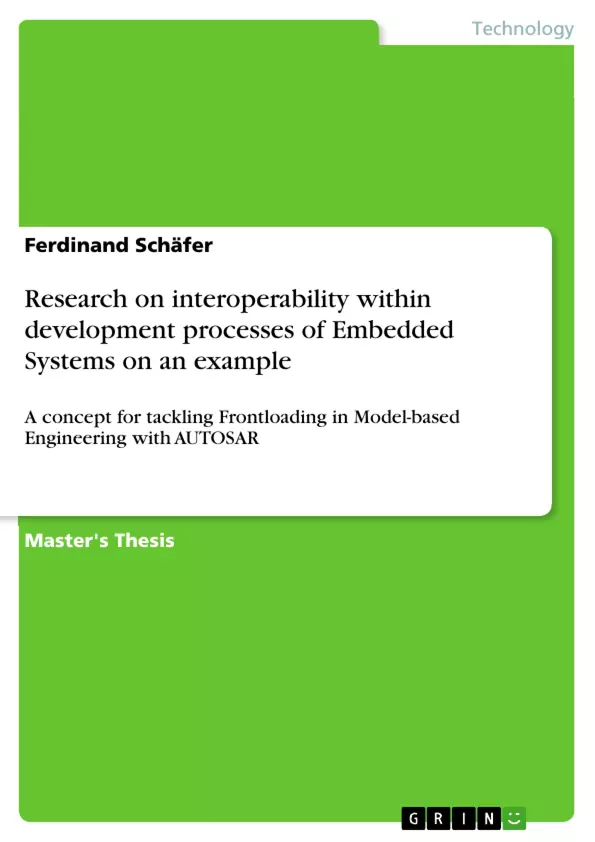This master thesis investigates the standard AUTOSAR („AUTomotive Open System ARchitecture“) within the ARTEMIS Joint Undertaking project CRYSTAL (“CRitical sYSTem engineering AcceLeration”), which is concerned with the development of interoperability-technology for System Engineering Environments. This work identifies a conflict between the application of the development-scheme “AUTOSAR-Methodology” and the superior industrial trend of Model-based Software Engineering. Founded on specialized literature, the mentioned problem can be titled as “Frontloading”. This methodological issue is such a fundamental aspect for the utilization of AUTOSAR that the present elaboration concentrates on it and refrains from interoperability-technology as focused by the paramount project. In the light of the motivation indicated in the acronym of CRYSTAL, clarifying this methodological aspect constitutes a fundamental contribution to efficiency in the engineering of Embedded Systems. This master thesis elucidates in detail the phenomenon “Frontloading” and its symptoms in software-development with AUTOSAR. The elaboration is based on a rich automotive function-example, which is developed in accordance with the established paradigm of Model-based Software Engineering. Although AUTOSAR adheres to the latter, its application demands own specific procedures to produce automotive functions. This work finally delivers a concept for the efficient handling of AUTOSAR within Model-based Software Engineering with respect to Frontloading, associating requirements to corresponding development-artefacts.
Inhaltsverzeichnis (Table of Contents)
:- Introduction
- Presentation of CRYSTAL
- Origin of the project
- Mission of CRYSTAL
- Overview of project‐contents
- Contributions of earlier projects to CRYSTAL
- The CRYSTAL‐consortium
- Project‐structure
- Location of this master thesis within CRYSTAL
- Relevance of interoperability to automotive system engineering
- Understanding interoperability
- Definitions for interoperability
- Example in business‐process
- Interoperability in process‐management
- Analogy for interoperability
- Introducing AUTOSAR
- Presentation of AUTOSAR
- Motivation for AUTOSAR
- Insight into development of automotive functions
- AUTOSAR‐Methodology
- Specifying application‐software with the Virtual Functional Bus
- The activity “Develop Application Software”
- Frontloading as a cause for inefficiency in engineering with AUTOSAR
- Model‐based Software Engineering in the V‐Model
- AUTOSAR within Model‐based Software Engineering
- The price for easing software‐integration: Frontloading
- Round‐Trip‐Engineering with Software Components
- Frontloading: An interoperability‐problem?
- Summarizing Frontloading
- Clarifying Frontloading with AUTOSAR in Model‐based Software Engineering
- Setup for observation
- Presentation of the exemplary embedded function for this master thesis
- UML use case diagram
- User‐requirements
- Description of Frontloading within AUTOSAR
- Signification of the Basis‐Software
- Meaning of architecture in an AUTOSAR‐development
- Architecture and non‐functional requirements in AUTOSAR
- Summarizing Frontloading
- Fundament of Model‐based Software Engineering
- Model‐based Software Engineering with the executable specification
- Comparison of architecture in the executable specification and the Virtual Functional Bus
- Decomposition as fundament for Model‐based Software Engineering
- Development of AUTOSAR Software Components for the spoiler‐functionality
- Systematic procedure with the spoiler‐functionality
- Approaching Virtual Functional Bus architecture with the executable specification
- The Virtual Functional Bus as component‐architecture
- Handling different kinds of Software Components at the Virtual Functional Bus
- Decomposition of the spoiler‐functionality with operational requirements
- Pushing the decomposition of the spoiler‐functionality from the logical perspective
- Summary of the actual state of decomposition
- Comparison of the present development‐status with the specification of the VFB
- Mapping of Software Components to Electronic Control Units
- Status of the Internal Behavior in the Software Component Description
- Mapping of Software Components to Electronic Control Units
- Developing Internal Behavior of Software Component Descriptions
- Transition from architecture to design
- First steps for the modelling of Software Component Descriptions
- Aspects to be specified in the Internal Behavior
- Specifying the Internal Behavior of the Software Components on the Ecu‐Spoiler
- Relations to Operating Systems and communication‐stacks
- Model‐based implementation of Software‐Components
- Summary of the specification of the Internal Behavior
- Involving System Services for the Application‐SWC‐Main‐Functionality
- Concept for efficient development of application‐software with AUTOSAR
- Context of the elaborated concept
- The challenge of Frontloading
- Summarizing the development of the spoiler‐functionality
- Possible reasons for iterations in the development
- Concept for efficient development of AUTOSAR application‐software
- List of abbreviations
- Table of figures
- Tables
- Bibliography
- Appendix
- Classification of requirements
- Non‐functional operational requirements for the spoiler‐functionality
- Model‐based documentation of the spoiler‐functionality with a state‐chart
- System‐requirements for the spoiler‐functionality for detailing of Table 1 and development of a state‐chart
- 2nd decomposition of the spoiler‐functionality from a logical perspective
- Overview for Software Component Description for modelling of the spoiler‐functionality in this thesis
- Summary of relevant AUTOSAR‐contents
- Non‐functional development requirements for the spoiler‐functionality
- Mapping of Software Components to Electronic Control Units
- Response‐times for the spoiler‐functionality
- Communication‐matrix
- Clarification of signals in addition to the communication‐matrix
- Specification of the Internal Behavior of Software Components on the Ecu‐Spoiler
- Rates of execution for the Runnables on Ecu‐Spoiler
- Information for the usage of MATLAB in this thesis
- Exemplary requirements for the usage of System Services in the spoiler‐functionality
- Arbeit zitieren
- Ferdinand Schäfer (Autor:in), 2014, Research on interoperability within development processes of Embedded Systems on an example, München, GRIN Verlag, https://www.grin.com/document/292686



